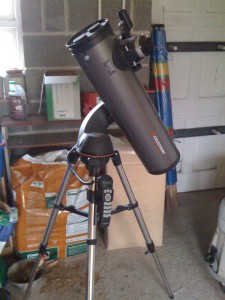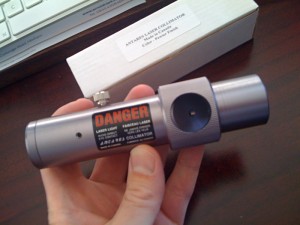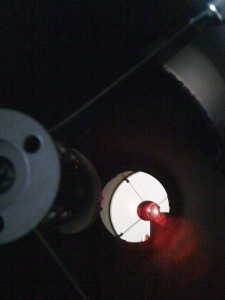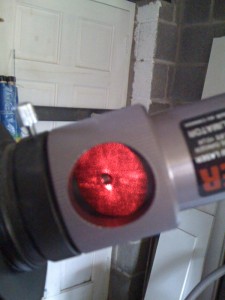With all this exciting space-type stuff in the news of late, I’ve had the urge to turf my telescope out of the garage and find out what sort of state it’s in.
My trusty old telescope has been woefully neglected for a few years … I did drag it out a few months ago, spontaneously, in the middle of the night, because my brother-in-law was visiting and he had a sudden desire to have a look at the stars(!). Sadly, this occasion mostly just made me realise precisely how much I’ve forgotten about astronomy (and — for that matter — precisely how much I’ve forgotten about how to set up and operate my ‘scope!). We did manage to see _some_ stuff (a very fuzzy venus, and a couple of star clusters)… but the telescope’s tracking and optics were noticeably off, and the sky conditions weren’t really ideal for seeing anything particularly exciting that night anyway.
Nevertheless, the experience was enough to prompt me to think about re-aquainting myself with the hobby a bit later in the year, once the skies got a bit darker.
It’s now a bit later in the year, and the skies have got a bit darker.
This is my telescope. It’s a Newtonian telescope, with computer-controlled tracking and a 130mm (5 inch) aperture. There’s a truism with amateur astronomy which says that no matter how big a telescope you have, you always wish you’d bought the next size up… but it’s a decent little scope, which had very good reviews at around the time I bought it, and I’ve seen some pretty nifty things through it.
I wasn’t really sure what sort of state it would be in, as I haven’t examined it (in daylight, at least) for quite a while. Newtonian telescopes use a very high-quality, precision-ground mirror to capture light, and after a number of years, the surface of these mirrors tends to tarnish a bit, and they don’t work very well any more. Getting your mirrors shiny again is a time-consuming and/or expensive process… so if the mirror was looking grubby, this whole project (which I’m keen to do… but no *so* keen that I actually want to throw a lot of money at it) would pretty much be a non-starter. Fortunately, I was pleased to discover that the primary mirror still looks bright, shiny and new (at least to my casual eye!). ‘Phew.
Next task: Sorting out the mirror alignment. Because the mirrors in these things are a bit on the delicate side, and because of awkward physical considerations like material expansion and stuff like that, they can’t be bolted firmly into place … instead, they’re suspended on a system of clips, springs, and screws, which tend to move around a bit over time, and require periodic adjustment. Having been left in an unheated garage for a few years (and therefore subjected to some variable temperatures and a fair bit of expansion movement), my primary mirror was *way* off alignment… and I wasn’t entirely sure that the secondary mirror was quite where it should be either.
It takes a fair bit of fiddling, skill and practice to achieve an optimal alignment. Or, failing that… TECHNOLOGY!
Fortunately, I have one of these things:
This is a laser collimator (“Collimation” being a fancy word for “getting all your telescope optics in alignment”), and it makes mirror alignment really easy. It mounts where your eyepiece would normally go, and shines a laser beam down your telescope…
If your mirrors are all perfectly positioned, the beam’s exit path and return path should be identical… and the laser will shine back in on itself. There’s a plate inside the collimator where you can see the beam shining back towards its source… in this (somewhat fuzzy – sorry!) pic, you can see the beam hitting just a millimetre or so below the hole – a couple of screw-turns later, the red dot disappeared back into it’s source, and the telescope was collimated.
…well, actually, that makes it all sound considerably easier than it actually was; I haven’t done this for a few years and it took quite a while — and considerable experimentation — to remember how all the screws and adjustments work. It’s good working practice to tilt the telescope towards the floor while you’re adjusting things … so that if you end up dropping a tool, or screw, or whatever, it doesn’t fall down the tube and hit the mirror. This proved to be sound advice, as I fumbled an alan key once or twice during the process. The disadvantage: back-ache from bending over the tube for a prolonged period. Doh! Still, at least a sore back will fix itself … a dinged mirror would’ve been a more formidable problem.
And so, with my mirrors in perfect alignment, I decided that this was enough science (/back-ache) for one day. Next time: sorting out the spotting scope.
(to be continued…)





 Follow
Follow